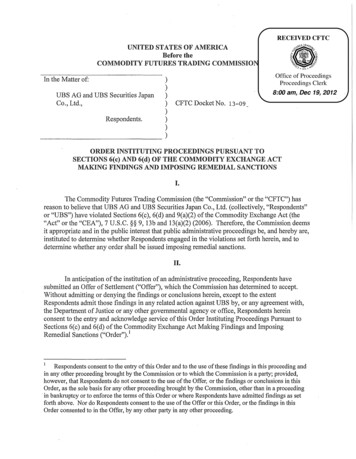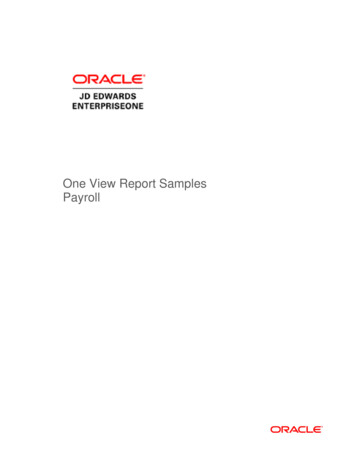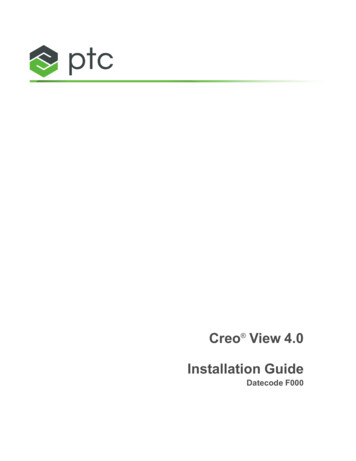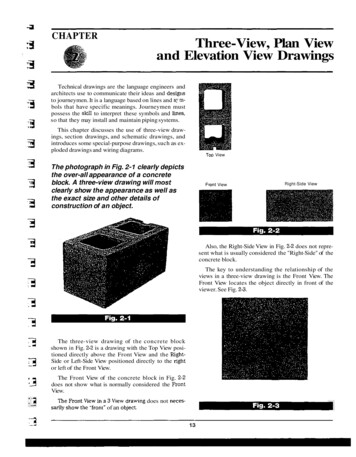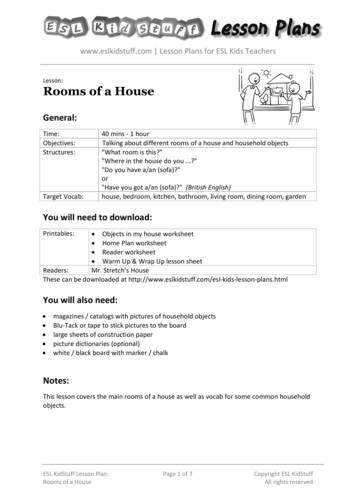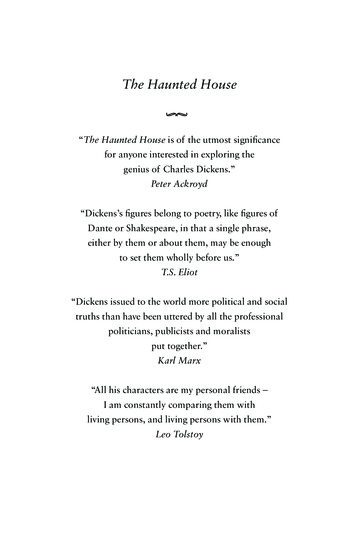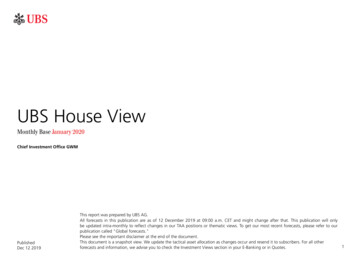
Transcription
UBS House ViewMonthly Base January 2020Chief Investment Office GWMPublishedDec 12 2019This report was prepared by UBS AG.All forecasts in this publication are as of 12 December 2019 at 09:00 a.m. CET and might change after that. This publication will onlybe updated intra-monthly to reflect changes in our TAA positions or thematic views. To get our most recent forecasts, please refer to ourpublication called "Global forecasts."Please see the important disclaimer at the end of the document.This document is a snapshot view. We update the tactical asset allocation as changes occur and resend it to subscribers. For all other1forecasts and information, we advise you to check the Investment Views section in your E-Banking or in Quotes.
Financial Market Outlook – short termGlobal Tactical Asset AllocationEM vs. DM growth difference towiden in 2020Annual real GDP growth in % includingUBS forecasts Some back and forth between China and the US regarding a potential Phase 1 trade deal has kept investors busy over the past month and causedsome market volatility. As the December 15 deadline approaches and the outcome can be binary, we think a neutral allocation to equities iswarranted. We remain skeptical on the prospect of a meaningful trade deal anytime soon, but our base case is an agreement that avoids furtherescalation. Economic data is tentatively suggesting a stabilization of global growth, but no acceleration yet. We keep our overweight positions inEM sovereign bonds and a basket of EM currencies, as the environment remains supportive of carry trades, with global central banks providingstrong monetary stimulus. To become more positive, we are looking for signs of a sustainable economic recovery and a significant trade agreement.On the flip side, a breakdown in trade negotiations would cause our outlook to deteriorate again.8.07.06.05.04.03.0 2.01.020122013Growth difference2014201520162017Advanced countries2018 2019E 2020EEmerging countriesNote: EM emerging markets; DM developed markets.Source: Haver, CEIC, national statistics, UBS, as of December2019 US equities offer better earningsoutlook than EurozoneConsensus earnings-per-share (EPS) vs.UBS CIO forecast121086420-2-4-65.5 -3.0USEMU2019 consensus2019 CIO forecastGlobal2020 consensus2020 CIO forecastSource: Thomson Reuters, UBS, as of December 2019Foreign exchangeWe keep an overweight in the US dollar against the Australian dollar (AUD) as deteriorating economic conditions in Australia are likely to keepthe country's central bank on an easing path, while the AUD remains exposed to US-China trade tensions. Our EM currency basket (overweightIndian rupee and Indonesian rupiah versus the AUD and Taiwan dollar) aims to earn the interest rate advantage without being too strongly exposedto US-China trade tensions.3.3-4.0BondsAfter very strong returns in 2019, the outlook for 2020 is more muted, as bond yields have fallen. Still, against a backdrop of very easy monetarypolicy globally and mediocre economic growth, selecting the right carry assets remains a promising strategy. We hold an overweight position in EMsovereign bonds in USD over high grade bonds. The current yield of 5% remains attractive, as central banks keep interest rates low and the growthdifferential between emerging and developed markets is likely to widen in the quarters ahead. Recent idiosyncratic risks (e.g. from Ecuador) havenot spilled over into the broader asset class, highlighting its current resilience and well-diversified nature.4.31.0EquitiesWe overweight US over Eurozone stocks. Should economic data weaken, we think the Federal Reserve has more leeway to act than the EuropeanCentral Bank (ECB). Consensus expectations for earnings growth look more realistic in the US than in the Eurozone. We also overweight Japaneseover Eurozone equities. While both regions are geared toward global growth and exports, Eurozone stocks have outperformed and are alreadypricing in a significantly better outcome compared to the Japanese market.0.02011Asset allocation Longer-term asset allocation (1–4 years)While we generally recommend to hedge the currency risk of non-domestic equity positions, we have removed these hedges for UK and Japaneseequities. The British pound and the Japanese yen are substantially undervalued and thus offer significant appreciation potential over the comingyears, outweighing the benefits of currency hedging.For further information please contact Co-Head CIO Global Asset Allocations Andreas J Koester, andreas.koester@ubs.com or Mark Andersen, mark.andersen@ubs.com. or CIO asset classspecialist Philipp Schöttler, philipp.schoettler@ubs.com2
Cross-asset preferencesWe like.EquitiesBonds Japanese equities Emerging market sovereign bonds in USD Foreign exchange We don't like. Model portfolios (EUR & USD)Risk Parity Liquidity2%5%Eurozone equitiesUS equitiesHedge Funds18%Global quality stocksUS TIPS 2%"Buy-write" strategy on US equitiesUS smart betaGlobal green bonds Mind the gap: Corporate "rising star"candidatesTime to be more selective in EM creditUS dollar versus.EM FX (INR, IDR) versus.Japanese yen (1–4-year horizon) versus.British pound (1–4-year horizon) versus.High gradebonds10.5%Developed market high grade bondsEUREquities US14%Mind the gap: Corporate "fallen angel"candidates.Australian dollar.DM FX (AUD, TWD).base currencyHedge Funds18%.base currencyHedge FundsHigh yieldbonds5%EM bonds7.5%Equities others4%Equities EM4%Equities Europe20% Inv. gradecorporatebonds 8%Risk Parity Liquidity2%5% High gradebonds8.5%US TIPS4%Inv. gradecorporatebonds8%High yieldbonds5%USDPrecious Metals& CommoditiesEquities US23%Recent upgradesRecent downgradesEM bonds7.5%Equities others5%Equities Europe Equities EM5%9%Source: UBS, as of 12 December 2019Note: Portfolio weightings are for a EUR model portfolio and aUSD model portfolio, with a balanced risk profile (including TAA).We expect the EUR balanced portfolio (excluding TAA) to havean average total return of 2.8% p.a. and a volatility of 7.9% p.a.over the next seven years. We expect the USD balanced portfolio(excluding TAA) to have an average total return of 5.1% p.a. anda volatility of 7.9% p.a. over the next seven years.3
Global tactical asset allocationTactical asset allocation deviations from benchmarkunderweightneutralCurrency rweightUSDEquities an*EMSEKAustraliaNOKBonds totalHigh grade bondsCADCorporate bonds (IG)High yield bondsNZDEM sovereign bonds (USD)AUDEM corporate bonds (USD)EM local currency bondsEM FX basket**TIPSDuration overlay (USD)DM FX basket**Duration overlay (JPY)Base currencyHedge Fundsnew (up to 12m horizon)oldnew (up to 12m horizon)oldnew (1-4 years horizon)Source: UBS, as of 12 December 2019Source: UBS, as of 12 December 2019Please note that the bar charts show total portfolio preferences, which can be interpreted as therecommended deviation from the relevant portfolio benchmark for any given asset class and sub-asset class.*Currency exposure of Japanese and UK equities is not hedged.** EM FX basket contains Indian rupee and Indonesian rupiah. DM FX basket contains Australiandollar and Taiwanese dollar (all equally weighted).4
CIO themes in focusEquities US smart beta Certain stock characteristics (momentum, quality, small capitalization, risk-weighting, value, and yield) have been shown to deliver long-term investment outperformance relative to a marketcapitalization-weighted index. Combining these characteristics, known in the industry as smart beta, makes the investment less cyclical and creates a "passive-plus" solution. Smart beta'scompelling value proposition has resulted in considerable growth in assets. Smart beta ETF assets have risen to over USD 750bn and are growing by more than 30% a year.Generate yield: "Buy-write" on US equities An equity buy-write strategy involves buying equities (the "buy" part) while selling (or "writing") call options that cover the position, typically on a monthly schedule. In exchange for givinga counterparty the right, but not the obligation, to buy the underlying asset at a predetermined price, the buy-writer receives a premium. Over an economic cycle, equity buy-write strategiesgenerate attractive risk-adjusted returns as they capture both the equity and volatility risk premium. They are most appealing when equity returns moderate and market momentum eases.Global quality mattersThe quality factor aims to reflect the performance of companies with durable business models and sustainable competitive advantages. It therefore targets companies with a high return onequity, stable earnings, and low financial leverage. In the late stages of the business cycle, when economic growth slows down and volatility rises, quality matters. As trade uncertainties remain,a global sector-neutral quality strategy can also offer added downside protection in a relative context.Bonds Green bonds: Sustainability meets late-cycle stability We view green bonds as a sound, sustainable alternative to global investment grade (IG) bonds. While an individual green bond usually performs in line with an otherwise identical non-greenone, the green bond market has a more conservative sector and risk profile and benefits from demand for sustainable investments outgrowing supply. This should lead to outperformanceduring times when credit risk premiums rise, making green bonds an appealing late-cycle investment, following the recent recovery in credit risk premiums globally. To benefit from greenbonds’ less cyclical profile, investors should diversify broadly and in particular avoid issuer concentration risk.Mind the gap: Investing in the crossover zone Investors able and willing to stomach the potential volatility of "crossover credit" investments can earn potentially significant alpha if key rating agency action is anticipated correctly. Whilewe emphasize that investments in BBB or lower quality bonds are not suitable for risk-averse investors, we provide credit views on the issuers trading in the crossover area. We also offer longand short bond baskets to help investors navigate the crossover zone.Time to be more selective in EM creditWith this theme, we provide advice on how to build diversified exposure to emerging market (EM) credit, drawing from our top-down view on the asset class, as well as the bottom-upinsights of our credit analysts. Emerging market credit should benefit from accommodative global liquidity conditions, resilient (though slowing) global economic growth, and sound creditfundamentals, as well as the relative attractiveness of the asset class versus other credit market segments. That said, as we move toward a later stage of the global business cycle, selectivitywill remain paramount in 2020. We expect risks to remain two-sided, providing opportunities for active investors to adjust their exposure toward the most promising opportunities.This selection of themes is a subset of a larger theme universe. It represents the highest conviction themes of the UBS Chief Investment Office GWM, taking into account the current market environment and risk-returncharacteristics.UBS Chief Investment Office GWM considers the highlighted themes as fitting the sustainability framework.5
CIO longer-term investment themes in focusEquities ObesityUrbanization and rising per capita GDP in emerging markets will contribute to the prevalence of obesity globally in the coming decades. Western economies are most associated with theobesity epidemic, but it is no longer just a rich-world problem. Based on current trends, the combined population of obese and overweight adults globally could exceed 40% by 2030. Medical devicesThe world's aging population and the growth of the over-65 age group will create more opportunities for companies selling medical products and devices. Other drivers of the medicaldevice industry include better penetration in emerging markets due to improved infrastructure, new innovative treatments, increased affordability due to rising per-capita GDP, and a growingprevalence of "lifestyle diseases" like obesity due to urbanization. We expect sustainable mid-single-digit revenue growth. Emerging market infrastructure Growing urbanization and the expansion of megacities in emerging markets are driving demand for infrastructure investment. Spending on EM infrastructure is expected to grow to USD 5.5trillion from the current USD 3 trillion, bringing its share of global spending to two-thirds by 2025 from the current half. Inadequate urban and nationwide infrastructure acts as a bottleneckto economic growth, making infrastructure investment a national priority.SpaceThe sharp decline in launch costs is lowering entry barriers to space. We forecast the space economy will grow from USD 340 billion currently to almost USD 1 trillion in the next couple ofdecades, catalyzed by sustained capital investment by new-economy billionaires. Investment exposure at this early stage is best gained via existing listed companies in the aerospace, satellite,and communications segments. New space startups may offer investment opportunities in private markets. Water scarcityWater is essential to life and represents a key driver of economic growth. Unfortunately, fresh water is distributed unequally worldwide. As the world's population grows, the planet's limitednatural resources are subject to increasing strain, which in turn can detract from social and economic prosperity. Population growth alone is a problem, but how and where it takes place canmake resource management that much more of a challenge. While urbanization provides a major boost to GDP growth, it also requires vast amounts of scarce water. Many countries confrontthe increasing challenge of water scarcity while some face overabundance. We see attractive long-term investment opportunities in water that are likely to remain valid for decades.This selection of themes is a subset of a larger theme universe. It represents the highest conviction themes of the UBS Chief Investment Office GWM, taking into account the current market environment and risk-returncharacteristics. The Longer Term Investments (LTI) theme series focuses on inevitable global trends, such as population growth, aging, and urbanization, that create a variety of opportunities, with certain companies andsubsectors experiencing a higher-than-GDP rate of revenue growth. Here, we include a subset of a larger universe of LTI themes expected to offer good entry points for theme-oriented investors in the coming months,and highlight our preference for a diversified approach to themes.UBS Chief Investment Office GWM considers the highlighted themes as fitting the sustainability framework.6
Key Investment RisksSelected scenarioBase caseKeydownsidescenariosManagedslowdownScenario descriptionGlobal growth stabilizes around 3%.Major central banks retain an easing bias. Theglobal economyremains in "late-cycle" territory for atleast another six to 12 months.Trade talks break down. Tariffs on USD 160bnNewof Chinese goods come into effect on 15breakdown inDecember and China retaliates. US growth fallstrade talks withbelow trend and the risk of a US recession risestariff increasesignificantly.EuropeaneconomicslowdownThe Eurozone economy tips into recession,driven by a further deterioration in the Sino-UStrade dispute beyond announced tariffs ora tit-for-tat tariff escalation between the USand the EU.Trade talksmomentumbuilds withtariff removalThe US and China agree on a phase I deal androllback of tariffs, and resolve core structuralissues such as forced technology transfer andChinese subsidies. Growth outlook in bothcountries improves considerably as uncertaintyfades.Europeangrowth reaccelaratesExternal headwinds fade and European growthrecovers faster than expected, given theEurozone economy's high reliance on globaltrade. Growth is supported by improvingdomestic demand, improved outlook in themanufacturing sector, and continued ECBstimulus.Key upsidescenariosExpected market performance for select asset classesGlobal equities 0% to 5% as we expect global earnings to remain low next yearUS rates to remain low as the Fed maintains the optionality to keep easingEURUSD rises toward 1.15 as Fed easing option and no additional tariffs help exportsGlobal equities - 15% to - 20% as earnings deteriorate and pressure on profit marginsrisesUS rates potentially fall to new historical lowsEURUSD at 1.10, assuming that tariffs would hurt European growth (else 1.15-1.20)EMU equities -10% to - 15% as weakness in manufacturing spill over to servicesEUR HY spread reaches 800bps amid higher default riskEURUSD below 1.05 driven by further ECB stimulusGlobal equities 5 to 10% with countries exposed to the global cycle leading upUS rates Short-term rates reprice higher while the long end hits a lower high, absentstructural reformsEURUSD 1.15-1.20 assuming Europe profits from improving global growth.EMU equities 5% to 10% with positive earnings growth in 2020EUR HY spread tighten to 300bps but rising government yields weigh on total returnsEURUSD at 1.20 as investors start pricing ECB policy tighteningExpected total returns over a 6-month horizon. FX and spread levels as of end of Q2 2020.Note: Upside and downside scenarios are possible events outside of CIO's base case expectations.Please refer to the last published Global Risk Radar edition for further details on the risk scenarios and investment implicationsFor further information please contact CIO strategist Dirk Effenberger, dirk.effenberger@ubs.comSource: UBS, as of December 20197
Key financial market driver 1 - Central bank policyKey points Faced with rising risk premiums as a result of trade uncertainty, central banks have tended to keep policy accommodative in 2019.This is acting as an insurance policy to maintain existing levels of activity. A debate seems to be starting in central bank circles about the merits of prolonged periods of negative interest rates. The decisionof Sweden's Riksbank around negative rates and any subsequent policy reaction will be watched by markets. The Swiss NationalBank remains a fan of keeping rates below zero. The major central banks are signalling a pause in policy moves in the near term. Having taken out insurance, policymakers seemunwilling to add further stimulus when underlying economies remain strong.Chinese import prices seem to have little to dowith US consumer pricesAverage (2014-2019) import price inflation from Chinaversus domestic US consumer price inflation, % y/y ratesRemaining accommodative, no significant policy shiftsCIO view (Probability: 60%*) The Federal Reserve has eased policy this year despite extremely low unemployment rates. Economic growth, while slowing, isnot exceptionally weak. It seems that the interest rate cuts to date have been an insurance to manage uncertainties created bythe current trade conflict. Any significant escalation of the trade conflict (impacting the real economy) may force additional easing in the US andelsewhere. The Fed seems unlikely to reverse the 2019 rate cuts quickly, even if there is some resolution to the dispute withChina. The European Central Bank is clearly divided over recent policy moves. However, there does not seem to be a consensus tochange policy in the near term.More aggressive policy easing as macro backdrop worsensPositive scenario (Probability: 20%*) Political policy errors threaten economic growth either through more aggressive trade disruption or weaker US or Europeangrowth. Central banks respond to the changing economic outlook with easing that goes beyond our base case forecasts.Policy breakthroughs reduce uncertaintyNegative scenario (Probability: 20%*) A comprehensive US-China deal on trade reduces real economic risk. Investment spending and business confidence recover morethan expected. Central banks focus on the economic cycle, and hint at or move toward policy normalization.*Scenario probabilities are based on qualitative assessment.Key datesJan 3Jan 23Jan 29Jan 30Source: Haver, UBS, as of 4 December 2019German retail savers may pay the negative interestrate taxGerman overnight bank retail deposit rates – which maynow go below 0%US Federal Reserve minutesECB policy decisionUS Federal Reserve policy decisionBank of England policy decisionSource: Haver, UBS, as of 4 December 2019For further information please contact Chief Economist Paul Donovan, paul.donovan@ubs.com8
Key financial market driver 2 - Earnings growth shouldimproveKey points Corporate profit growth remains sluggish. But headwinds should begin to fade. Leading to better growth in 2020.Credit standards remain supportive for further EPSgrowthFed loan officer survey and S&P 500 EPS growth60%Earnings soft patch poised to improveCIO view (Probability: 60%*) US earnings growth has been pressured this year due to fading fiscal stimulus, slower global growth, rising tariffs, lowercommodity prices, and a stronger US dollar. Still, a material decline in profits looks unlikely. Leading indicators such as access tocapital remain supportive, suggesting that profit growth should improve in 2020. At a sector level, 2019 profits are down sharply in the energy and materials sectors. Tech (especially semis) and industrialsearnings are also lower. But with signs that the global industrial and commodity cycles are bottoming, along with lowersemiconductor inventories, these sectors will not likely be a drag in 2020. We continue to expect S&P 500 EPS of USD 164 ( 1% y/y) in 2019 and USD 173 ( 5% y/y) in 2020, and await greater clarity onUS-China trade policy and its impact on the global economy. In the fourth quarter, we expect earnings growth to be flattish to slightly positive. The energy, materials, and industrials sectorswill continue to be weak but the tech and financials sectors should see some improvements relative to prior quarters. We expect profit margins to fall 0.4% in 2019. Still, we don't expect a sustained margin decline. The weakness is due to slowrevenue growth and idiosyncratic factors such as investment spending in communication services and currency headwinds inconsumer staples and tech. Most of the pressure is not due to rising wages. Labor-intensive consumer discretionary companiesare the most exposed to higher wage costs but, outside of this sector, the average company should be able to offset higherwages through greater productivity and targeted price increases. Also, bear in mind that higher wages typically translate intofaster consumer spending.Positive scenario (Probability: 20%*)Central bank stimulus and trade dispute resolution Aggressive global central bank stimulus and a resolution to the trade dispute between the US and China drive a reacceleration ingrowth.Negative scenario (Probability: 20%*)Downturn in sentiment Trade and geopolitical tensions flare up, depressing business and consumer sentiment. Wage pressures, without improvingconsumer and business demand, crimp profit margins and earnings growth rates. Declines in long-term interest rates pressurefinancial sector earnings.*Scenario probabilities are based on qualitative assessment.Key datesJan 15-40Credit standards easing40%-2020%00%20-20%40-40%-60%199060Credit standards tightening80199520002005201020152020S&P 500 EPS y/y (left)Senior loan officer survey (right, inverted, advanced 9m)Source: Bloomberg, UBS, as of 5 December 2019Anticipate improvement in global cyclical sectorsEarnings growth, UBS CIO estimatesHealth CareUtilitiesReal EstateComm ServicesFinancialsCons StaplesCons %2019-10%20200%10%Source: FactSet, UBS, as of 5 December 20194Q earnings season kicks off with banksFor further information please contact CIO strategists Jeremy Zirin, jeremy.zirin@ubs.com, David Lefkowitz, david.lefkowitz@ubs.com or Edmund Tran, edmund.tran@ubs.com.9
Global economic outlook - SummaryKey points Slowing investment has slowed global growth, to a level somewhat below trend. The lack of significant imbalances in the globaleconomy means that a more significant slowdown remains low probability. Consumer demand remains firm in most major economies. In particular, consumers remain willing to purchase more expensiveitems, which suggests a degree of confidence in their future employment, and the overall economic outlook. While a US-China trade deal would be positive economically, it is unlikely to restore trust in the world trade order. Re-imposingtariffs on Argentina and Brazil reminds companies that any trade deal can be reversed.Global growth below trend for nowCIO view (Probability: 50%*) Trade uncertainty continues to be felt via weaker investment spending. Trade matters more to equity markets than it does to thereal economy. A partial trade deal between China and the US would have a positive but limited impact on this. Avoidance ofexisting trade taxes through supply-chain shifts has increased and should continue to blunt their negative impact. There is someevidence of a stabilization or modest improvement in global trade volumes. Manufacturing-sensitive, investment-focused economies like Germany have already felt the consequences of trade tensions.However, recent Asian and European data offer some signs of more stable growth. Labor market strength is continuing in most major economies, supporting consumers' income (via increased employment,increased wages, or both). Global unemployment is near a 40-year low. Domestic demand should limit the drag from the exportand investment weakness. However, the longer the downturn in investment continues, the greater the risk it will spill into labor markets and weakendomestic demand. Underlying inflation trends remain relatively benign, with companies absorbing trade taxes rather than passing them on. The effectof strong labor markets should be monitored.Proposed taxes on US consumers of French product- Champagne and skincare matter mostComparison of French share of US imports and value ofFrench exports to the USSource: UBS calculations from US Census Bureau data, as of 4 December 2019Global labour markets remain very strongThe OECD unemployment rate is at the lows for thismillenniumFaster return to trend growthPositive scenario (Probability: 25%*) Trade uncertainty recedes after a breakthrough in US-China negotiations, triggering a recovery in investment spending. Labormarkets continue to support consumer demand. The fiscal and monetary stimulus measures in Europe and Asia support economic growth.Negative scenario (Probability: 25%*)Trade escalation pushes the world economy toward a severedownturn Trade tensions escalate, unsettling business confidence further. Companies decide to retrench, meaning not only lowerinvestment, but also attempts to cut labor costs. This weakens consumer spending. Limited monetary and fiscal-policy measures are insufficient to counter a fast global downturn.*Scenario probabilities are based on qualitative assessment.Key datesJan 10Jan 29US employment reportUS Federal Reserve meetingSource: Haver, UBS, as of 4 December 2019For further information please contact Chief Economist Paul Donovan, paul.donovan@ubs.com, CIO Chief Economist Eurozone Ricardo Garcia, ricardo-za.garcia@ubs.com or CIO USEconomist Brian Rose, brian.rose@ubs.com10
US economy - Slower growth amid trade disputesKey points Economic growth is likely to remain at or below trend. Core inflation should hit the Fed's 2% target in 2020. The Fed remains on hold for now.PMIs have moved lowerISM manufacturing PMI and non-manufacturing index6560Moderate expansionCIO view (Probability: 50%*) GDP is likely to expand at or below the 2% potential growth rate in the quarters ahead. Job growth has slowed and the number of job openings has declined, suggesting that demand for labor has softened. However,the labor market remains very tight, with the unemployment rate near a 50-year low. Rising wage income should continue to support consumer spending, which is the main driver of overall economic growth. Strong profits and labor shortages provide an incentive for businesses to invest. However, political uncertainty is acting as aconstraint. Further escalation of trade disputes would pose a serious threat to the recovery, while a solid US-China agreementcould boost growth. The manufacturing sector is struggling amid the trade disputes, with the purchasing managers' index below 50 since August,and manufacturing output is down year-to-date. Domestic demand should provide enough support to prevent a severedownturn. Residential investment turned positive in 3Q19 and should trend higher. Mortgage rates have declined, and demand for housingshould be supported by the strong labor market. We expect core PCE inflation, which excludes food and energy prices, to reach the Fed's 2% target in 2020. The Fed cut rates by a total of 75 basis points between July and October, and is now signalling a neutral stance. The Fed still hasroom to cut further if economic conditions deteriorate.5550452009 2010 2011 2011 2012 2013 2014 2014 2015 2016 2017 2017 2018 2019Manufacturing PMINon-manufacturing IndexSource: Bloomberg, UBS, as of 4 December 2019ISM Institute for Supply ManagementPMI Purchasing Managers' IndexInflation is below the Fed's targetCore PCE inflation3.02.5Fed inflation target2.01.5Growth reboundPositive scenario (Probability: 20%*) A breakthrough in trade negotiations removes uncertainty, allowing business investment to strengthen and GDP growth torebound. The Fed refrains from further rate cuts, but rate hikes remain unlikely within the next 12 months unless inflationsurprises to the upside.More severe slowdownNegative scenario (Probability: 30%*) Trade disputes, political uncertainty, and tighter financial conditions weigh on business investment. Weaker demand for laborundermines consumer
Smart beta ETF assets have risen to over USD 750bn and are growing by more than 30% a year. Generate yield: "Buy-write" on US equities An equity buy-write strategy involves buying equities (the "buy" part) while selling (or "writing") call options that cover the position, typically on a monthly schedule.
